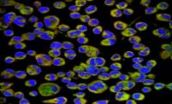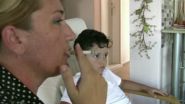(Press-News.org) Scientists from the University of Granada have successfully created magnetic bacteria that could be added to foodstuffs and could, after ingestion, help diagnose diseases of the digestive system like stomach cancer. These important findings constitute the first use of a food as a natural drug and aid in diagnosing an illness, anywhere in the world.
The researchers—members of Bionanomet, the Metallic Bionanoparticle research group of the Department of Inorganic Chemistry and the Institute of Biotechnology of the University of Granada—have conducted this research in collaboration with BIOSEARCH SA, a private company. Their results have been published in the latest issue of Advanced Functional Materials.
To design these magnetic bacteria, the researchers looked to Nature. They tried to copy magnetobacteria, which naturally produce very limited numbers of internal magnets that, essentially, provide them with a means of orienting themselves as if they possessed an internal compass.
Biomedical applications
These artificial magnetic bacteria could have biomedical applications in magnetic resonance imaging—to facilitate diagnosis—or in heating malign cells through magnetic hypothermia and, thus, curing diseases like cancer.
This new technology—patented by BIOSEARCH SA—is still only in an experimental phase but it will facilitate the use of these probiotic bacteria, common in food, to diagnose and treat tumours and as an edible iron supplement.
INFORMATION:
This research has been financed by IDEA, the regional government of Andalusia's Agency for Innovation and Development. The project has led to the registration of a patent for the technology and its applications and to a first publication in one of the most highly ranked journals in the field of applied materials.
Reference:
Artificial Magnetic Bacteria: Living Magnets at Room Temperature
Miguel Martín, Fernando Carmona, Rafael Cuesta, Deyanira Rondón, Natividad Gálvezand José M. Domínguez-Vera.
Advanced Functional Materials. 2014
DOI: 10.1002/adfm.201303754
Artificial magnetic bacteria 'turn' food into natural drugs
Scientists from the University of Granada are the first to develop magnetic bacteria that, as part of food intake, help to diagnose digestive diseases like stomach cancer
2014-05-12
ELSE PRESS RELEASES FROM THIS DATE:
Recombinant adenovirus-mediated 3β-hydroxysteroid-Δ24 reductase inhibits neural apoptosis
2014-05-12
3β-Hydroxysteroid-Δ24 reductase (DHCR24) is a multifunctional enzyme that localizes to the endoplasmic reticulum and has neuroprotective and cholesterol-synthesizing activities. DHCR24 overexpression confers neuroprotection against apoptosis caused by amyloid β deposition. Dr. Xiuli Lu and colleagues from Liaoning University in China constructed two recombinant adenoviruses (Ad-rSYN1-DHCR24-myc and Ad-hSYN1-DHCR24-
myc) that drive DHCR24 expression specifically in neuronal cells. They also found that adenovirus transfection inhibits apoptosis through scavenging ...
Endocrine disruptors impair human sperm function
2014-05-12
HEIDELBERG, 12 May 2014 – A plethora of endocrine-disrupting chemicals interfere with human sperm function in a way that may have a negative impact on fertilization. These are the findings of a German - Danish team of researchers from the Center of Advanced European Studies and Research in Bonn, Germany, and the University Department of Growth and Reproduction, Rigshospitalet, Copenhagen, Denmark. The work, which is published in EMBO reports, suggests that endocrine disruptors may contribute to widespread fertility problems in the Western world in a way that hitherto has ...
Ultra-fast, the bionic arm can catch objects on the fly
2014-05-12
With its palm open, the robot is completely motionless. A split second later, it suddenly unwinds and catches all sorts of flying objects thrown in its direction -a tennis racket, a ball, a bottle-. This arm measures about 1.5 meters long and keeps an upright position. It has three joints and a sophisticated hand with four fingers. It was programmed at the Learning Algorithms and Systems Laboratory at EPFL (LASA) and designed to test robotic solutions for capturing moving objects. It is unique, as it has the ability to catch projectiles of various irregular shapes in less ...
Children of nicotine-addicted parents more likely to become heavy smokers
2014-05-12
VIDEO:
The more time a child is exposed to a parent addicted to smoking, the more likely the youth will not only take up cigarettes but also become a heavy smoker,...
Click here for more information.
WASHINGTON -- The more time a child is exposed to a parent addicted to smoking, the more likely the youth will not only take up cigarettes but also become a heavy smoker.
So warns a team of researchers led by Georgetown Lombardi Comprehensive Cancer Center scientists in Pediatrics. ...
ADHD treatment associated with lower smoking rates
2014-05-12
DURHAM, N.C. -- Treating attention deficit hyperactivity disorder (ADHD) with stimulant medication may reduce smoking risk, especially when medication is taken consistently, according to an analysis led by researchers at Duke Medicine.
The findings appear online May 12, 2014, in the journal Pediatrics.
"Given that individuals with ADHD are more likely to smoke, our study supports the use of stimulant treatment to reduce the likelihood of smoking in youth with ADHD," said senior author Scott Kollins, Ph.D., professor of psychiatry and behavioral sciences and director ...
US cervical cancer rates higher than previously reported, especially among older women
2014-05-12
BALTIMORE – May 12, 2014. Cervical cancer rates in the United States are higher than previously believed, particularly among 65- to 69-year-old women and African-American women, according to a study led by a researcher at the University of Maryland School of Medicine published in the journal Cancer. Current U.S. cervical cancer screening guidelines do not recommend routine Pap smears for women over 65 if their prior test results have been normal.
Previous research finds an age-standardized rate of about 12 cases of cervical cancer per 100,000 women in the United States, ...
New research sets stage for noninvasive monitoring of HIV-induced peripheral neuropathy
2014-05-12
Philadelphia, PA, May 12, 2014 – Corneal nerve fiber assessment has great potential as a tool to diagnose and monitor peripheral neuropathy induced by HIV, say scientists at the Johns Hopkins University School of Medicine. The results of their study are published in The American Journal of Pathology.
Although corneal nerve assessments have shown increasingly valuable as a replacement for epidermal nerve fiber evaluation in diabetic peripheral neuropathy, the evaluation of corneal alterations in tracking HIV-induced neuropathy has yet to be explored.
"The cornea is ...
Current guidelines underestimate US cervical cancer incidence and older women's risk
2014-05-12
Rates of cervical cancer in American women may be higher than previously thought, and the disease may arise most often at an age when adequately screened women are advised to stop getting screened. The findings come from a new study published early online in CANCER, a peer-reviewed journal of the American Cancer Society. The results should be taken into consideration when the national guidelines for cervical cancer screening are reviewed.
Removal of the uterine cervix through a hysterectomy eliminates a woman's risk of developing cervical cancer, but previous estimates ...
Fourfold increase in the rate of diagnosed cases of Celiac disease in the UK
2014-05-12
Coeliac UK, the national charity for coeliac disease announces today, 12th May 2014, new research from the University of Nottingham that has found a fourfold increase in the rate of diagnosed cases of coeliac disease in the United Kingdom over the past two decades, but, still three quarters of people with coeliac disease remain undiagnosed. ¹
The National Institute of Health & Care Excellence (NICE) previously estimated that only 10 - 15% of those with coeliac disease had been diagnosed, however, this latest research by Dr Joe West from University of Nottingham, funded ...
Research suggests human microbiome studies should include a wider diversity of populations
2014-05-12
Microbial samples taken from populations living in the U.S. and Tanzania reveal that the microbiome of the human hand is more varied than previously thought, according to new research published in the journal Microbiology. These findings suggest that the 'standard' hand microbiome varies depending on location and lifestyle.
Results compared the microbes on the hands of women in the U.S. and Tanzania and found that organisms that have commonly been identified in prior human skin microbiome studies were highly abundant on U.S. hands, while the most abundant bacterial species ...
LAST 30 PRESS RELEASES:
Numbers in our sights affect how we perceive space
SIMJ announces global collaborative book project in commemoration of its 75th anniversary
Air pollution exposure and birth weight
Obstructive sleep apnea risk and mental health conditions among older adults
How talking slows eye movements behind the wheel
The Ceramic Society of Japan’s Oxoate Ceramics Research Association launches new international book project
Heart-brain connection: international study reveals the role of the vagus nerve in keeping the heart young
Researchers identify Rb1 as a predictive biomarker for a new therapeutic strategy in some breast cancers
Survey reveals ethical gaps slowing AI adoption in pediatric surgery
Stimulant ADHD medications work differently than thought
AI overestimates how smart people are, according to HSE economists
HSE researchers create genome-wide map of quadruplexes
Scientists boost cell "powerhouses" to burn more calories
Automatic label checking: The missing step in making reliable medical AI
Low daily alcohol intake linked to 50% heightened mouth cancer risk in India
American Meteorological Society announces Rick Spinrad as 2026 President-Elect
Biomass-based carbon capture spotlighted in newly released global climate webinar recording
Illuminating invisible nano pollutants: advanced bioimaging tracks the full journey of emerging nanoscale contaminants in living systems
How does age affect recovery from spinal cord injury?
Novel AI tool offers prognosis for patients with head and neck cancer
Fathers’ microplastic exposure tied to their children’s metabolic problems
Research validates laboratory model for studying high-grade serous ovarian cancer
SIR 2026 delivers transformative breakthroughs in minimally invasive medicine to improve patient care
Stem Cell Reports most downloaded papers of 2025 highlight the breadth and impact of stem cell research
Oxford-led study estimates NHS spends around 3% of its primary and secondary care budget on the health impacts of heat and cold in England
A researcher’s long quest leads to a smart composite breakthrough
Urban wild bees act as “microbial sensors” of city health.
New study finds where you live affects recovery after a hip fracture
Forecasting the impact of fully automated vehicle adoption on US road traffic injuries
Alcohol-related hospitalizations from 2016 to 2022
[Press-News.org] Artificial magnetic bacteria 'turn' food into natural drugsScientists from the University of Granada are the first to develop magnetic bacteria that, as part of food intake, help to diagnose digestive diseases like stomach cancer

